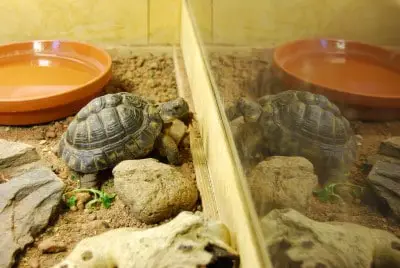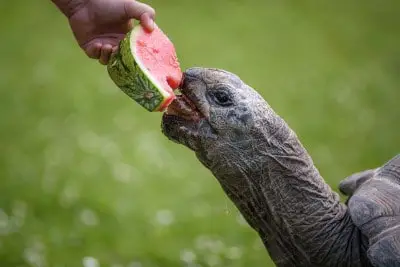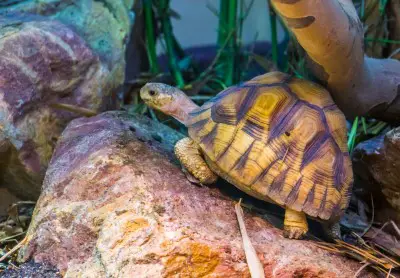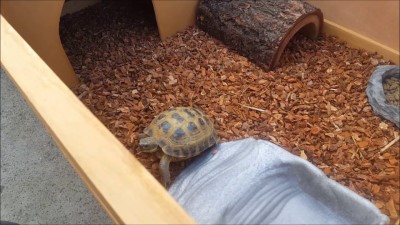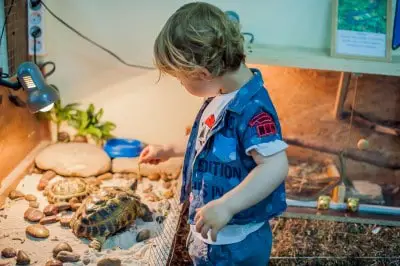Tortoises, like other reptiles, are cold-blooded animals, meaning they obtain heat from external sources. The sun provides all the warmth they need when in the wild, but, in captivity, they rely entirely on you to offer alternative artificial heat. Therefore, with a lamp like TEKIZOO Sun Lamp, your pets will have improved immunity and overall health.
If you are worried about which light will work for you, we’ve got you covered. We have selected some of the best tortoise heat lamps available, explaining their features, pros, and cons. Read on.
In this article, we’re going to review the following heat lamps & UVB bulbs:
- Zacro Reptile Heat Lamp
- TEKIZOO Sun Lamp
- Zilla Fluorescent T8 Bulb
- Zoo Med Reptisun Fluorescent UVB
- MIXJOY Mercury Vapor Bulb
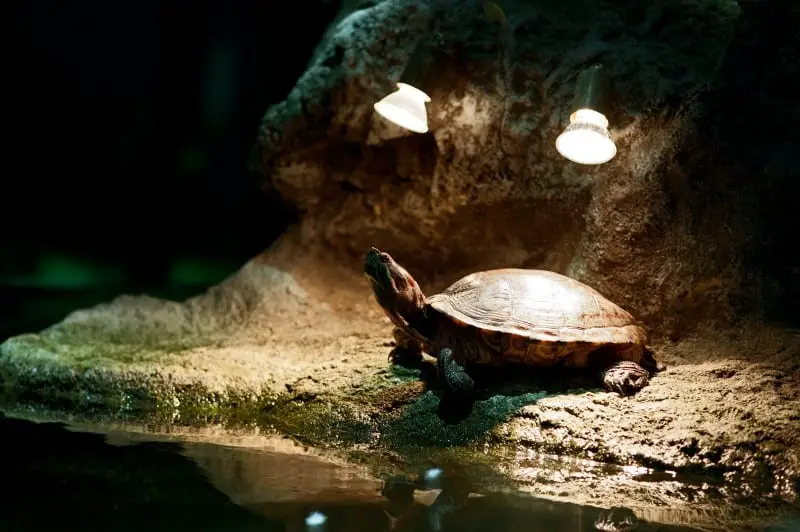
A Review of 5 Best Tortoise Heat Lamps & UVB Bulbs
Given all the information you need to look for a suitable heat lamp, you can evaluate your options better. Therefore, we have compiled the best tortoise heat lamps, all effective to keep your pet healthy.
1. Zacro Reptile Heat Lamp
This lamp is suitable for most reptiles and is of high quality. It is made of safe ceramics and is effective in emitting 100 W of light and heat. Most users attest that it is durable and long-lasting compared to other glass options. The manufacturers brilliantly attached a thermometer and batteries to it.
With this lamp, your pet is sure of efficient and well-distributed heat, a feature that comes in handy during harsh winters to keep them warm. Moreover, the light has sound radiation that can heat the cage well, even if made from glass.
The lamp isn’t large, but it has high energy, enough to warm your pet’s cage for 24hrs. The long lifespan is another plus since it can provide more than twenty thousand hours. Thanks to the digital thermometer, you can closely monitor the temperature levels and adjust when necessary to prevent overheating.

The Zacro reptile heat lamp is ideal for any pet owner, but some precautions are crucial. First, avoid touching the light once it is plugged in or immediately after use since it can be fatal. Secondly, don’t place it too close to your pet. To be sure, you also need to use a recommended lamp holder.
Pros
- It is of good quality and pocket-friendly
- It is long-lasting and produces high energy
Cons
- It can cause burns if you handle it incorrectly
2. TEKIZOO Sun Lamp
As an exotic pet keeper, it is necessary to do as much as you can to make your tortoise feel comfortable in its new environment by possibly creating a replica of the wild. This is where Tekizoo comes in; it provides you an all-in-one bulb that emits UVB, UVA, lighting, and heat, just like the sun.
With this lamp, your pet will feel the sun’s natural feel even while at a designated corner in your house. The elements that your pet obtains from this bulb are vital for its health and synthesis of vitamins responsible for strong bone formation. The Tekizoo super sun lamp has a wattage of 125 W and is efficient for reptiles and amphibian pets to bask.

The bulb is flexible for use in most enclosures, and the amount of heat it emits is manageable. However, since it is a powerful light, it is best to fix it some inches away from the cage. You should also check your terrarium’s size before purchasing it because if too big, the heat may not be very effective since it will cover a small section. In contrast, if your tank is too small, the bulb may be too powerful for your tortoise and lead to overheating.
Pros
- It provides heat, UVA, and UVB
- It improves the pet’s health by promoting vitamin synthesis
Cons
- It cannot work with a rheostat or a thermostat
- The bulb is quite pricey
3. Zilla Fluorescent T8 Bulb
Zilla provides a range of products ideal for your reptiles and amphibians’ well-being. Whether you are a beginner or a veteran keeper, Zilla got you covered for your heat lamp needs. UVB is necessary just like food; hence, with a T8 Fluorescent bulb, your pet is confident of a continuous supply of UVB elements, vital for the manufacturing of minerals needed for bone development and general health. It may last up to two years, but the efficiency may reduce over time. Hence, experts advise replacing it at least once annually.

When used appropriately, the desert fluorescent bulb can last for more than three thousand hours. Other than UVA and UVA emissions, the bulbs light up the enclosure giving you a clear view of your little buddy. We recommend this kind of lighting for all pets, but you should also back it up with a non-lighting heat bulb to work at night to avoid disturbing your tort’s peaceful sleep.
Pros
- The fluorescent bulb is easy to fix.
- It can work effectively in a relatively large terrarium
Cons
- It has low wattage
4. Zoo Med Reptisun Fluorescent UVB
Zoo Med doesn’t disappoint when it comes to quality pet products. This product entails a coiled fluorescent bulb that effectively emits UVB and heat. With a 30% and 10% UVA and UVB, they can provide all the needed ultraviolet needs for your reptiles. This 10.0 UVB variant works best for desert torts accustomed to a lot of heat, while the 5.0 alternative is excellent for forest species. When you have this lamp, your tortoise will synthesize Vitamin D for calcium, promoting a healthy shell and bones.

The UVA helps stimulate the tortoise’s reproduction and appetite and provides it at the recommended rate. This bulb is designed to give you both heat and light, and it allows you to install it in any way or angle to suit your enclosure, whether your fixture is vertical or horizontal. You don’t have to set up multiple bulbs, saving you money and space you would have used for bulb holders. Also, you are not restricted to face the lamp in a specific direction; any position will emit light and heat.
Pros
- It is affordable
- It emits both heat and UVB
- You can position it in any direction, and it won’t interfere with its performance.
Cons
- It is not long-lasting
5. MIXJOY Mercury Vapor Bulb
Another great product is this UVB bulb that produces light and heat, and it effectively emits far-reaching UV, enough to simulate sunlight. It can reach distant parts of the enclosure, as far as 14 inches. It is a powerful lamp of about 100 W, and you can use it during the day. Not only is it a great heat source, but the UV it provides helps keep your pet healthy. The bulb guarantees that your tortoise doesn’t miss out on the sun’s essential nutrients even as it stays indoors.
Its lighting is ideal for most reptiles like bearded dragons and snakes; thus, it will work for tortoises. You can also install it on any setup, desert, or jungle because it is compatible with all enclosure types; you can use it for your cages, tanks, and terrariums. The bulb effectively mimics the tortoise’s natural setup, as it emits warmth and a basking feeling. It is also easy to install because it is self-ballasted, enabling you to set it up on any fixture.
Pros
- It is compatible with different enclosure types
- It is effective with any other reptile
Cons
- It is not ideal for every tortoise species
What is the Right Temperature for Your Tortoise?
The ideal temperature level will depend on your tortoise’s needs. Most reptiles, regardless of their species, thrive at around 212 Fahrenheit.
Owners always strive to provide these conditions using a heat lamp, especially since the indoors can be pretty chilly, especially at night. The amount of heat that reaches the tortoise also depends on the bulb’s wattage and the lamp’s distance from the enclosure. If the light is close to the tortoise, the heat will be more intense than when the bulb is further away.
There are 50, 75, and 100 W bulbs, which should be at different distances from the enclosure, with the lowest wattage bulb being the closest. To be sure, you can use a thermometer to evaluate the temperature levels and fluctuations to act accordingly.
The first adjustment is to push the bulb closer or further from the enclosure. Note that the lamp should not heat the entire terrarium; one spot will suffice while the rest remain cool. It will give your pet the chance to draw near the hotspot for heat and move away to cool off.
What To Look for in a Heat Lamp
Using UVB rays, tortoises can absorb essential nutrients such as vitamin D, necessary for calcium absorption. They naturally obtain it from the sun, but thanks to technology, a UVB bulb works well when you have an indoor pet.
Despite hundreds of products being available, not all of them are effective for your tortoise. Therefore, in your search for an ideal option, we will help you by giving you the primary aspects to look for in the best tortoise heat lamp.
Wattage
The first factor to consider is the lamp’s wattage. The options usually range from 50-100 watts, depending on the bulb type and its price tag. When you have the right power, your tortoise will immensely benefit. If the wattage is too low, the UVB level will also reduce, leaving your tortoise to receive minimal nutrients to help in calcium synthesis. On the contrary, a heat-emitting bulb with excess wattage can lead to dire consequences. Since the tortoise absorbs heat in the environment to raise its temperature, providing too much can lead to overheating or burning.
Experts recommend that you use a UVB with a wattage of around 75-100 watts. Anything below may be too little, and anything more than 100 W may cause complications. The suitable wattage depends on the enclosure’s size, how many tortoises you have, and their sizes. You may need a low wattage bulb if the pen is small since light will cover every area. Similarly, you don’t need a potent bulb if you have few and small-sized tortoises.
Read more: How Much Does a Pet Tortoise Cost? (Initial and Yearly Cost Breakdown)
Lifespan
Heating lamps, like typical household bulbs, can explode or malfunction. Given that they emit heat, they can fail due to overpowering. When you pick a bulb for your tort, be careful about the brand since there are many imitations and counterfeit products in the market.
Do your research first, and, if possible, find someone who owns the same lamp to help guide you in choosing the best heat lamp for your tortoise. Once you purchase one, we recommend testing it first before placing it in the enclosure; this way, you will tell whether it will explode or not.
Most manufacturers provide tips to increase the lamp’s lifespan. For starters, it would help if you had a long-lasting bulb. Averagely, the bulbs need to be on for up to ten hours a day each day. Thus, your tortoise lamp should have a long lifespan. One relief is that you don’t need to use the light at night unless when it’s cold. During such harsh conditions, owners can use high wattage bulbs for their pet’s sake.
Functionality
As a tortoise owner, what do you want your heat lamp to do for you? There are different bulb types; some are for lighting, others for heating, and others emit light and heat simultaneously. If you already have a lighting system, you can go for a heating lamp, but it is more cost-effective to purchase a multipurpose one. Besides heat, they also need to facilitate nutrient synthesis using UVA, UVB, or both. You may find a bulb that emits both rays or instead go for one that exclusively heats the enclosure.
Remember that the heating lamp is not supposed to heat the entire enclosure. The reptiles need high and low temperatures due to the temperature fluctuations in their bodies. To be safe, you can have a heated section and a separate area to cool off to prevent overheating. The enclosure should not be of the same high temperature, just as it should not be too cold. This is why some owners go for heat mats for their terrariums.
The Lamp Type
Heating and lighting lamps have bulbs that connect to the lamp to make them glow, heat up, or both. There are various types of lights available depending on the product and its functionality.
First, we have the basking lights, which are perhaps the most common bulbs. They provide both heat and light and have high wattages of almost 100 W. When lit, they produce waves and focus them on a particular enclosure area. Given how powerful they are, they are susceptible to catching fire and wrecking the entire lamp fixture. For such bulbs, ensure that your system can support the wattage and monitor it for any changes.
Next, there are ceramic heat lamps. They are different in that they only emit heat and are not a lighting system. They will be effective if you don’t need a lighting bulb or during the night when you only require heat. An upside to these bulbs is that they have a longer lifespan than light bulbs and work well when the humidity is high. However, these options are pricier than the typical light bulbs.
We also have coiled bulbs that have a low wattage but are very effective in heat emission. Some even emit UV light for use in Vitamin D synthesis. The only concern is to get a quality bulb that is not too bright to blind the tortoise.
Lastly, there are the mercury vapor bulbs that are an all-inclusive option. They provide light, heat, and UVB and come with high wattages. Therefore, you need to ensure that your fixture can accommodate the high voltage; or else, it may cause a fire. Always go for the bulb that will serve you best depending on your needs but ensure that it is compatible with your light system and enclosure.
Wrap Up
Besides food and water, tortoises need heat for growth and development. Since they get natural light when living in the wild, they need something similar when they are in captivity. UVB and UVA from the sun are essential for their bones and shells. Therefore, it is imperative to purchase a bulb that provides these rays besides heat and light.Our favorite lamp is the TEKIZOO Sun Lamp since it emits the required rays and has powerful light. It is also durable and lasts long to keep serving you. Alternatively, if you want an exclusive heating lamp, you can go for Zacro Reptile Heat Lamp. It is also high quality and has the advantage of functioning without emitting light, enabling you to use it even at night.


